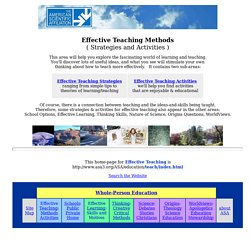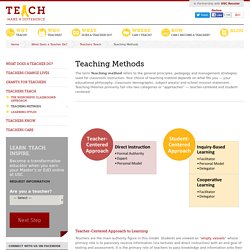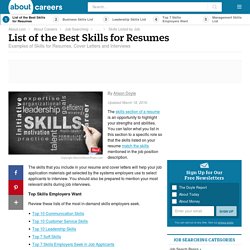

Effective Teaching Methods — Strategies & Activities. This area will help you explore the fascinating world of learning and teaching.

You'll discover lots of useful ideas, and what you see will stimulate your own thinking about how to teach more effectively. It contains two sub-areas: Of course, there is a connection between teaching and the ideas-and-skills being taught. Therefore, some strategies & activities for effective teaching also appear in the other areas: School Options, Effective Learning, Thinking Skills, Nature of Science, Origins Questions, WorldViews. The 49 Techniques from Teach Like a Champion. Teaching Methods and Strategies: Use These Tips to Motivate & Inspire Your Students.
Teaching Methods/Subject Area Resources Links. Teaching Techniques & Strategies – Center for Excellence in Learning and Teaching. Teaching Styles. The term Teaching method refers to the general principles, pedagogy and management strategies used for classroom instruction.

Your choice of teaching method depends on what fits you — your educational philosophy, classroom demographic, subject area(s) and school mission statement. Teaching theories primarily fall into two categories or “approaches” — teacher-centered and student-centered: Teacher-Centered Approach to Learning Teachers are the main authority figure in this model. Students are viewed as “empty vessels” whose primary role is to passively receive information (via lectures and direct instruction) with an end goal of testing and assessment.
Student-Centered Approach to Learning While teachers are an authority figure in this model, teachers and students play an equally active role in the learning process. Direct Instruction Inquiry-Based Learning. 12 Unwritten Rules of Cell Phone Etiquette. There are some hard, cold truths to the way we use our cell phones, but they’ve become commonplace to the point of forming an accepted, unwritten code.

We all screen calls we should otherwise answer. We all reply to missed calls with texts. We pray to reach voicemail on calls we have to (but don’t want to) make. When we call someone and they don’t answer, and we know they looked at their phone and made a decision to ignore our call, we’re okay with that, because we likely, at some point in the day, did the same thing to someone else.
The following are twelve unwritten rules of cell phone etiquette: 1) Screening Calls Some people are disgracefully obvious when it comes to screening. There is, however, a time limit on whether a person has an obligation to pick up. And, for the record, excuses are completely permissible in cell phone etiquette, even if we know it’s only an excuse and not the truth.
You can, in this situation, simply close your phone, and end the call. Best Resumes 2014. What are employers looking for in resumes for 2014?

The most critical factor is results – what have you accomplished that meets the hiring needs of the company? It’s not enough to be qualified for the job. Rather, you need to clearly show the hiring manager why you are qualified. Results, Results, Results Employers are looking for candidates who can demonstrate that they have added value in prior jobs or internships. In order to get that information to the hiring manager, think about the bottom line for the various roles and jobs which you have held when writing job descriptions.
Be sure to state how your efforts impacted the bottom line and quantify the results whenever possible. Customization Counts. Tailor Your Resume to Your Audience. Came across a video the other day that provides tips for graduates who are looking for their first job.

What many entry-level candidates don’t realize is that the audience for their resume isn’t their mom, peer group or guidance counselor. It’s a hiring manager or a recruiter. Their preferences are what matter most. This video details what hiring managers want to see in a candidate’s resume. Hiring managers from Select Staffing, Target, and Robert Half, Intl. weighed in with their opinions on the following topics: Which Kind of Resume is Best? They discussed the differences and the pros/cons of reverse chronological or functional resumes. Should You Use an Objective? Although the hiring managers in this video used the term ‘objective’ interchangeably with ‘summary’, the two are quite different. Is it Wise to Include References? The hiring managers had no consensus on this. Page Length? The reasoning on this point was that the resume should contain only relevant information.
Skills for Resumes (Types, Examples and Skills Lists) Updated March 18, 2016.

The skills section of a resume is an opportunity to highlight your strengths and abilities. You can tailor what you list in this section to a specific role so that the skills listed on your resume match the skills mentioned in the job position description. The skills that you include in your resume and cover letters will help your job application materials get selected by the systems employers use to select applicants to interview.
You should also be prepared to mention your most relevant skills during job interviews. Review these lists of the most in-demand skills employers seek. Review these comprehensive lists that include both hard and soft skills for each category. continue reading below our video Play Video.